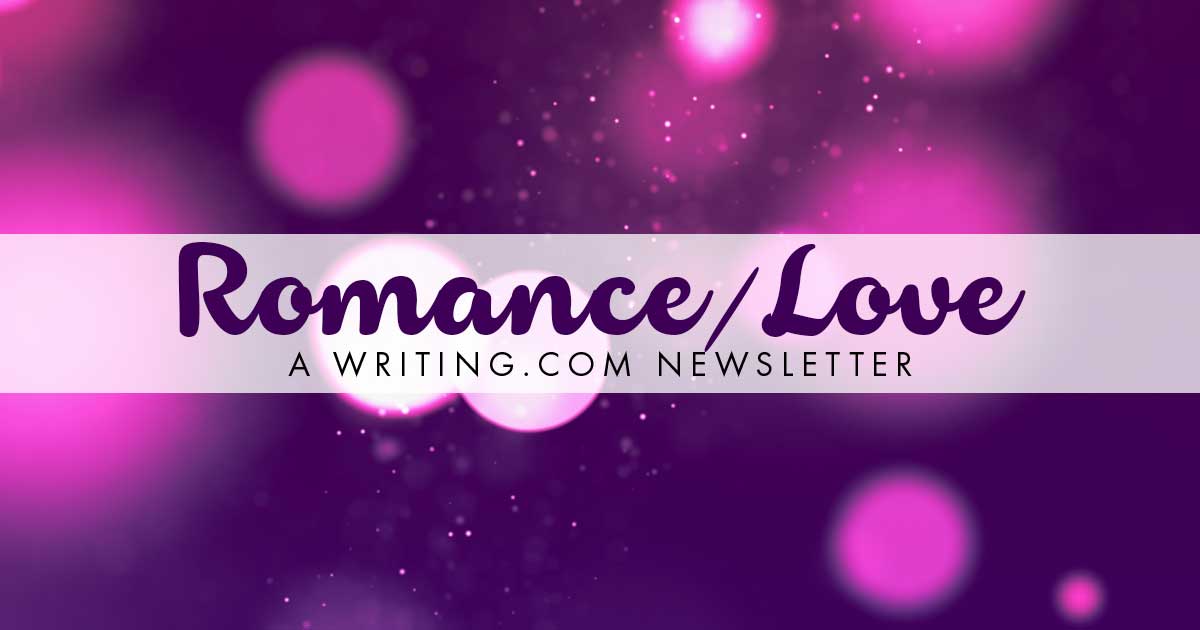This week: It's Romantic Poetry Month -John Keats Edited by: StephBee  
More Newsletters By This Editor 
![Table of Contents [#401437]
Table of Contents](https://shop.Writing.Com/main/trans.gif) ![Table of Contents [#401437]
Table of Contents Table of Contents](/main/images/action/display/ver/1709303267/item_id/401437.png)
1. About this Newsletter
2. A Word from our Sponsor
3. Letter from the Editor
4. Editor's Picks
5. A Word from Writing.Com
6. Ask & Answer
7. Removal instructions
![About This Newsletter [#401439]
About This Newsletter](https://shop.Writing.Com/main/trans.gif) ![About This Newsletter [#401439]
About This Newsletter About This Newsletter](https://www.writing.com/main/images/action/display/ver/1709303676/item_id/401439.png)
“I love you the more in that I believe you had liked me for my own sake and for nothing else.” – John Keats
“There is no charm equal to the tenderness of the heart.” – Jane Austen
April is National Pecan month. The first week of April, which I missed, was National Library Month. I remember as a little girl I would beg my mother to take me to the Library. That was back in the 1970’s. I loved books about the dinosaurs, the plants and the Hardy Boys. I had a card with a mental stamp. Nowadays, library cards look like credit cards. I took my boys to the library but it wasn’t the same. Maybe it was because it was too easy to get books elsewhere like Barnes & Noble or Amazon. Still, love your libraries. Great ideas start there.
Question for you: When was the last time you went to the library and what did you check out?
Did you know? The 3rd week of April is National Garden week. I just got done planting Bonzai plants, cilantro, summer squash, marigolds, basil and sweet peas. Wish me luck!
Does anyone else LOVE to garden? I’d love to hear what you’re planting this year!
April is also National Poetry Month. Exploring poems is a great way to rev up the writing muscles so this month I’ll be looking at the romance of John Keats & romantic poetry. Enjoy!
|
![Letter from the editor [#401442]
Letter from the editor](https://shop.Writing.Com/main/trans.gif) ![Letter from the editor [#401442]
Letter from the editor Letter from the editor](https://www.writing.com/main/images/action/display/ver/1709303784/item_id/401442.png)
Romanticism and Romantic poetry started to take off in the late 1790’s. Some of the poets in this period include: Elizabeth Barrett Browning, Percy Bysshe Shelley, Lord Byron, John Keats, Victor Hugo, Sir Walter Scott, and even Edgar Allen Poe. (Edgar Allen Poe, you say? Yes!)
Themes of this style of poetry included exploring individualism, a respect for the natural word, quest for beauty, a love of the past, physical and emotion passion, idealism and exploring the supernatural. John Keats embraced it all.
John Keats was born in 1795 and only lived 25 years. (He died of tuberculous) His poems were only published 4 years before he died, and he didn’t really gain fame for his poetry until years after. Keats studied to be an apothecary, but once he discovered poetry, that was it for him. All he wanted to do was be a poet. He loved romance, nature, poetry, and exploring the past.
Keats had two well known affairs, one with Isabella Jones and the other with Fanny Brawne. Fanny was probably his biggest emotional affair, while Isabella was probably his biggest physical affair.
Keats is well known for his “odes.”
Ode on a Grecian Urn
Ode to Melancholy
Ode to a Nightingale
Ode to Apollo
Ode to Fanny
His style accented sensuality. He also painted word pictures of heightened emotions through nature.
Here’s one of my favorites:
Sweet, Sweet is the Greeting of eyes
John Keats, 1818
Sweet, sweet is the greeting of eyes,
And sweet is the voice in its greeting,
When adieus have grown old and goodbyes
Fade away where old Time is retreating.
Warm the nerve of a welcoming hand,
And earnest a kiss on the brow,
When we meet over sea and o’er land
Where furrows are new to the plough.
Another favorite is “Bright Star,” originally began before Keats met Brawne, where Isabella Jones is the initial inspiration. Bright star follows the pattern of a Shakespearean Sonnet.
Bright Star
By: John Keats
Bright star! would I were steadfast as thou art—
Not in lone splendour hung aloft the night,
And watching, with eternal lids apart,
Like Nature's patient, sleepless Eremite,
The moving waters at their priestlike task
Of pure ablution round earth's human shores,
Or gazing on the new soft fallen mask
Of snow upon the mountains and the moors—
No—yet still stedfast, still unchangeable,
Pillow'd upon my fair love's ripening breast,
To feel for ever its soft fall and swell,
Awake for ever in a sweet unrest,
Still, still to hear her tender-taken breath,
And so live ever—or else swoon to death.
I hope you’ve enjoyed this look at John Keats and romantic poetry. Please share your favorite poems and I’ll post them in my May Newsletter.
|
![Editor's Picks [#401445]
Editor's Picks](https://shop.Writing.Com/main/trans.gif) ![Editor's Picks [#401445]
Editor's Picks Editor's Picks](https://www.writing.com/main/images/action/display/ver/1709303830/item_id/401445.png)
| |  | Invalid Item 
This item number is not valid.
#2212306 by Not Available. |
|  | Come With Me  (E) (E)
An invitation to build a romantic relationship, written in the terzanelle poetry form.
#2141531 by Dan I Am   |
Editor’s Note: This was inspired by 19th Century odes. I saw a lot of “Keats” inspiration in this one and gave it an award. Well done!
|
![Word From Writing.Com [#401447]
Word from Writing.Com](https://shop.Writing.Com/main/trans.gif) ![Word From Writing.Com [#401447]
Word from Writing.Com Word from Writing.Com](https://www.writing.com/main/images/action/display/ver/1709303874/item_id/401447.png)
Have an opinion on what you've read here today? Then send the Editor feedback! Find an item that you think would be perfect for showcasing here? Submit it for consideration in the newsletter!
https://www.Writing.Com/go/nl_form
![Ask & Answer [#401448]
Ask & Answer](https://shop.Writing.Com/main/trans.gif) ![Ask & Answer [#401448]
Ask & Answer Ask & Answer](https://www.writing.com/main/images/action/display/ver/1709303902/item_id/401448.png)
![Unsubscribe [#401452]
Removal Instructions](https://shop.Writing.Com/main/trans.gif) ![Unsubscribe [#401452]
Removal Instructions Removal Instructions](https://www.writing.com/main/images/action/display/ver/1709303960/item_id/401452.png)
To stop receiving this newsletter, click here for your newsletter subscription list. Simply uncheck the box next to any newsletter(s) you wish to cancel and then click to "Submit Changes". You can edit your subscriptions at any time.
|
